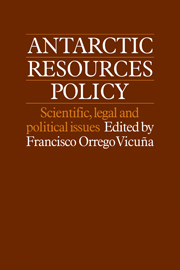Book contents
- Frontmatter
- Contents
- List of contributors
- 1 Antarctic resources policy: an introduction
- Part one The state of Antarctic knowledge and experience
- 2 Antarctica: its history and development
- 3 The living resources of the Southern Ocean: a scientific overview
- 4 The mineral resources of Antarctica: progress in their identification
- 5 Environmental factors in the development of Antarctica
- 6 Cooperation in the Antarctic: a quarter of a century's experience
- Part two The policy for the conservation of the living resources of Antarctica
- Part three The policy for the exploration and exploitation of the mineral resources of Antarctica
- Part four Issues on Antarctica and the law of the sea
- Part five The policy for Antarctic cooperation
3 - The living resources of the Southern Ocean: a scientific overview
Published online by Cambridge University Press: 06 July 2010
- Frontmatter
- Contents
- List of contributors
- 1 Antarctic resources policy: an introduction
- Part one The state of Antarctic knowledge and experience
- 2 Antarctica: its history and development
- 3 The living resources of the Southern Ocean: a scientific overview
- 4 The mineral resources of Antarctica: progress in their identification
- 5 Environmental factors in the development of Antarctica
- 6 Cooperation in the Antarctic: a quarter of a century's experience
- Part two The policy for the conservation of the living resources of Antarctica
- Part three The policy for the exploration and exploitation of the mineral resources of Antarctica
- Part four Issues on Antarctica and the law of the sea
- Part five The policy for Antarctic cooperation
Summary
Introduction
During recent years there has been a steady increase in the total world fish catch (including shellfish) to a plateau, reached in the early 1970s, of about 70 million tonnes per annum. Estimates of the total world potential of marine living resources of the conventional type indicate that the maximal sustainable catch is probably in the order of about 100 million tonnes. However, many of the remaining unexploited or relatively unexploited resources comprise species which are less attractive because of their low value, accessibility, etc. Thus the rate of increase from conventional sources is slowing down and more attention is now being directed towards the harvesting of unconventional resources of which many consider Antarctic ‘kril’ to be the most promising. Owing to the restrictions placed on many nations by the declaration of 200-mile exclusive economic zones, and the decline of stocks of some of the major fisheries in the Northern Hemisphere, a number of nations have underutilized or surplus capacity. Antarctic fisheries offer an attractive means of utilizing this capacity. It is in this context that the current interest in Antarctic living resources must be viewed.
The Southern Ocean
Although there is no general agreement concerning the northern limit of the Southern Ocean, biologists generally consider that it lies at the Antarctic Convergence which marks the northern limit of non-migrating Antarctic species. The deeper layers of this ocean are continuous with the three major ocean basins to the north (Atlantic, Pacific and Indian).
- Type
- Chapter
- Information
- Antarctic Resources PolicyScientific, Legal and Political Issues, pp. 21 - 60Publisher: Cambridge University PressPrint publication year: 1983
- 8
- Cited by



